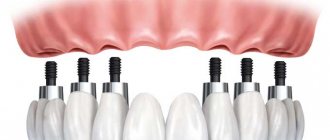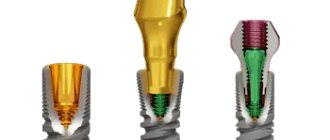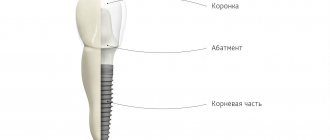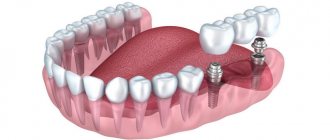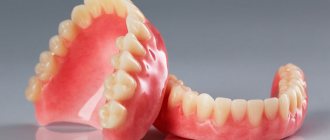What is a bridge What is a dental implant Comparison What to put on the front teeth What to put on the chewing teeth The right choice
A bridge and dental implant are designed to replace missing teeth. With the help of a bridge, only the outer, coronal part is restored. An implant is an artificial root made of titanium, which is integrated into the bone tissue, taking on the functions of a natural tooth root. Under equal conditions, a classic bridge is not able to compete with implantation. Although implant installation is a physiological technology, bridge prosthetics relying on one’s own teeth is not losing ground.
What is a dental bridge
A bridge is a non-removable orthopedic structure consisting of several artificial crowns. It allows you to restore a segment of missing dental units from 1 to 3 in a row. For fastening, two supports are required, which are your own teeth. Therefore, if the outermost units are lost (end defect), bridge structures are not used.
A classic bridge is a frame in the form of several crowns made of metal or precious alloys, coated with a layer of ceramic or plastic, or metal-free - ceramic or zirconium. The two outer crowns are hollow - they cover the supporting units. In order to hermetically fix the orthopedic structure, the supports are first depulped and ground, giving them a cone-shaped shape. The bridge is attached to the teeth with dental cement. It is impossible to remove the structure without damaging it.
Many specialists prefer not to tell their patients about the real disadvantages of classical prosthetics. The main one is the inability to stop the processes of bone tissue atrophy under the bridge. During implantation, not only the crown part is restored, but also the root. The jaw bone, acquiring its usual load, activates the processes of natural regeneration. Bone recession stops, and tissue volume is gradually restored.
Key Differences Between Dental Implants and Bridges
A prosthesis on an implant restores all the structural elements of a natural tooth – the root, neck and supragingival part (crown). The function of the root is performed by a screw rod, which is “implanted” into the bone tissue. A transitional element - an abutment - is fixed on it, and a crown of the color and shape of the removed unit is placed on top.
Pros of implants:
- The new tooth continues to put stress on the bone. Therefore, metabolic processes in it are preserved and atrophy slows down.
- The units adjacent to the defect remain intact.
- The gums around the restored tooth do not sag over time.
- With proper care, implants can last for decades.
A dental bridge is a series of three or four crowns welded together. The outermost ones look like hollow caps and are put on the supporting units. Medium ones - fill the gap in the row and rest on the gum.
What are dental implants
Implant-supported prosthetics differs from classical prosthetic technology. The method is based on the rehabilitation of the dentition without the involvement of healthy units. Instead of a missing or non-viable tooth, a separate implant is implanted - a titanium root that imitates a natural one, onto which an orthopedic structure (crown, bridge, complete denture) is fixed. With the help of dental implants, any number of units can be restored - from 1 to all in a row.
Indications for installation
Most often, such a metal-ceramic prosthesis is used to restore an entire fragment in a row, although it can also replace one missing tooth. The optimal length of a bridge fixed on living supports is 1-2 elements. It is recommended to place a structure 3-4 units long on implants. Otherwise, functional errors may occur, including overload and loosening of the supports.
When making dentures, dental technicians use impressions taken from the jaws in advance. Until the product is ready, the patient is offered a temporary structure to hide the aesthetic defect. The bridge is fixed on living supports using dental cement, on implants in the same way or by screw fixation. In any case, you will not be able to remove the prosthesis yourself; only a doctor can do this in a dental office.
Comparison of methods by characteristics
Prosthetics on implants and a bridge have a number of fundamental differences. Each technique has advantages and disadvantages. The doctor chooses the technology after assessing all factors.
Advantages
Implants are able to withstand increased chewing loads, distributing them evenly across the jaw, due to this they are not destroyed during operation. Unlike classic bridges on your teeth, which require systematic re-cementing, implants are implanted once and for life.
In the case of classic bridges, the load falls on the supporting teeth. This can lead to their gradual destruction and removal. The size of the prosthesis will increase until there are no units left to act as support. At the site of the defect, bone tissue atrophy will continue. Implantation solves this problem.
Flaws
The main disadvantages of implantation include:
- high cost - but considering that implants are installed for life, the costs are justified;
- many contraindications - currently the list of contraindications has decreased, new technologies have been developed;
- treatment period (if a two-stage protocol with delayed loading is used, accompanied by osteoplastic intervention) - one-stage technologies will allow you to restore the dentition in 1-3 days.
Installation of a bridge requires the preparation of two supports. It’s sad if you have to injure healthy units. Due to the uneven redistribution of mechanical load, bone tissue atrophy accelerates, the contour of the gum changes and sags. A gap appears between the bridge and the gum where bacterial plaque and food particles accumulate. Not all prosthetic structures are subject to repair and relocation. Teeth under crowns are subject to secondary caries, which will lead to rapid tissue destruction and an increase in the length of the defect.
Contraindications
Implantation is a surgical procedure with some contraindications. But unlike the classic bridge, a number of protocols can be used for serious periodontal pathologies, problems with bite, occlusion, and a complicated medical history.
Both methods are contraindicated in:
- inflammatory process of the oral cavity;
- infections in the acute stage;
- chronic diseases in the stage of decompensation.
Absolute contraindications to implantation include oncology and severe bleeding disorders. A bridge is not installed in cases of terminal and long-term defects (loss of 4 units in a row or more), malocclusion pathologies, or low height of dental crowns.
Possible complications
The survival rate of implant structures is 98-99.9%. But in rare cases, complications are possible - peri-implantitis (inflammation of the tissue around the implant), rejection of the artificial root. Engraftment of the implant structure requires the professionalism of the doctor and the patient’s compliance with the instructions in the postoperative period and beyond.
After installing a bridge structure, the neck of the supporting teeth may be exposed due to subsidence of the gums. With bruxism, restorations may fall out of the prosthesis. Due to improper redistribution of mechanical load, the bridge wears out faster, the supports under it become loose and shift.
Life time
The manufacturer indicates the service life of the implant is 20 years or more. With proper care and regular dental care, an artificial root will last a lifetime . An orthopedic structure installed on implants requires replacement no earlier than after 10-25 years (structures made of zirconium dioxide - 20 years and above).
The service life of a dental bridge, due to rapid wear due to bone subsidence, averages 6-10 years (depending on the material).
Price
When considering the question of what is cheaper, a bridge or an implant, we focus on the long term.
- Installing a metal-ceramic bridge of three artificial crowns costs 20-25 thousand rubles. per unit , zirconium - 40-60 thousand rubles per unit . Preparation is paid separately - depulpation of 2 support units costs 10-18 thousand rubles.
- Installation of a classic ROOTT implant on a turnkey basis costs 28 thousand rubles. , plus a metal-ceramic crown 28 thousand rubles. (zirconium - 35 thousand).
The final price of prosthetics is not too different. Considering that the bridge will have to be re-cemented every 6-10 years, which may require treatment and restoration of supporting units, implantation will allow for a more cost-effective restoration of the dentition.
Bridge or implant: which is better?
Dentist-orthopedist-therapist Tatyana Anatolyevna Medynskaya tells
Loss of a tooth requires immediate prosthetics, otherwise the adjacent teeth will begin to shift. There are 2 main methods used for treatment:
- A bridge prosthesis, which in everyday life is often called a “bridge”
- An implant, or more precisely, a crown supported by an implant.
Let's talk about each in more detail and consider situations in which it is advisable to choose one or another method.
Bridge prosthesis
This is a single non-removable structure that, with the help of crowns, rests on the teeth adjacent to the lost one. Diagram of a 3-unit bridge:
- Crown on a tooth
- Crown-space
- Crown on a tooth.
This design places certain demands on the abutment teeth. They must be strong enough to last for many more years.
At the same time, if the teeth are completely healthy - we call them intact - there is no need to cover them with crowns. The doctor will have to remove quite a lot of dental tissue, and this is very wasteful in relation to the patient’s health.
For bridges, it is optimal when the supporting teeth are already quite badly destroyed, 30-50% of the crown part. In this case, the pulp is preserved, or the root canals are successfully treated using modern methods.
Disadvantages of the method:
- Requires grinding of supporting teeth;
- Food debris may get under the prosthesis; careful hygiene is required;
- Does not protect against jawbone volume loss;
- Over time, an unaesthetic gap may appear between the gum and the crown-gap.
Advantages of bridges:
- Quick installation. Prosthetics can be started as soon as the gums at the extraction site have healed. The patient will have a temporary prosthesis made of plastic installed, and after a few days a permanent one will be made.
- Cost is often highlighted as an advantage of bridges, but it is not so clear cut. A little later we will compare the costs of both prosthetic options.
Implant
This is the most modern and complete method of treatment. The patient receives a new tooth - artificial, but indistinguishable from the real one.
They often say “implant” for short, but the correct name for the design is a denture on an implant, or in this case a crown on an implant. The implant itself is just an artificial tooth root, and we need the crown part too.
Disadvantages of the method:
- Long installation. The implant takes 4-6 months to take root, and if necessary, during this time the patient walks with a temporary structure to replace the tooth.
- More list of contraindications. Basically they are relative, that is, temporary: only until the problem is solved. But a number of diseases do not yet allow implantation: blood clotting disorders, some diseases of the heart, endocrine and nervous systems.
- Bone volume requirements. The jawbone decreases in volume if there is no load on it. This happens after tooth extraction if an implant is not installed in the first months. Bone is also lost during inflammation: due to cysts, granulomas, etc. To restore bone volume, a special operation will be required, and its cost directly depends on the size of the loss.
Advantages:
- The best aesthetics. Only you and your dentist will know about the implant.
- The load stimulates the jaw bone and protects it from decreasing in volume.
- No grinding of adjacent teeth required
- Many years later, the implant will still serve the patient for other designs. Including those that are used for the loss of all teeth.
Selection algorithm
I warn you, the table is very simplified. In practice, the doctor evaluates many more parameters. For example, how many teeth have been lost, how soon prosthetics will be required not only for the neighboring teeth, but also for those following it, etc.
| Choose statements that suit your situation | How to find out the answer | Bridge-shaped prosthesis | Implant |
| Teeth adjacent to the missing one require prosthetics | Ask your general dentist or prosthodontist | + | + — |
| There is a high probability that the abutment tooth will require treatment or removal in the next 5-7 years | The dentist-therapist will tell you based on the results of a CT scan (three-dimensional computed tomogram) | — | + |
| The volume of the jawbone is sufficient for implantation | The implantologist will tell you based on the CT results | — | + |
| There are absolute contraindications to implantation | Ask an implantologist | + | — |
| Lost tooth in the smile area | Smile widely in front of the mirror. Is the gum of the lost tooth visible? | + — | + |
Life time
With proper care and good health, the implant is installed once and for life. Many implant manufacturers offer a lifetime warranty on their products.
The service life - not to be confused with the warranty period - is the same for bridges and crowns on an implant: 10 years.
However, bridges are more vulnerable due to their supports. If at least one of the supporting teeth requires treatment, the entire structure will have to be replaced.
The patient may want to replace a still strong bridge for aesthetic reasons when a gap appears above the gum.
Price
At the time of installation:
- A 3 unit bridge costs slightly less than an implant with a crown.
- If depulpation or re-treatment of tooth canals is required, then together with the preparation, the bridge will be no cheaper, if not more expensive, than an implant.
- If the jawbone volume is insufficient, then installing an implant along with bone augmentation will cost significantly more.
When replacing a prosthesis: Replacing a crown on an implant costs almost 3 times less than a new bridge.
Thus, a bridge is cheaper at the time of installation, but will incur more costs in the future.
Care
The same hygiene items will be required:
- Toothbrush and toothpaste,
- Irrigator,
- Dental brushes or flosses and superflosses.
All this is also used when caring for your own teeth. But when a patient has a structure installed, the care requirements increase.
Food residues may accumulate under the bridge. In addition to morning and evening care, intermediate cleaning will be required after each meal. Rinsing thoroughly helps, but a brush or superfloss may be necessary. They are compact and easily fit into a pocket or cosmetic bag.
Do not use toothpicks to avoid causing inflammation of the gums around the implant or dental bridge!
Both methods, a bridge and an implant, successfully help replace a lost tooth. Consult your doctor to determine which method is best for you.
What to put on chewing teeth
In case of loss of molars, premolars, functionality comes first. The implant takes on the functions of a natural root and is able to withstand mechanical loads, correctly redistributing them to the jaw. In the case of a classic bridge, the load falls exclusively on the supporting dental units.
In the manufacture of orthopedic systems, the ROOTT clinic uses high-tech equipment and 3D computer modeling. This gives maximum accuracy of the prosthetic result. A crown or bridge that is tailored to your oral anatomy, bite, and occlusion is highly comfortable and will last much longer.
Advantages and disadvantages
Orthopedic structures made of metal ceramics have a number of important advantages:
- good functional characteristics;
- acceptable aesthetics;
- high quality, reliability and durability - the service life of such prostheses is 7-8 years when supported on your teeth and from 15 years when supported on implants.
But this type of prosthetics also has its drawbacks. This option is not suitable for patients with metal allergies. It is also not recommended for restoration of the smile area, since the metal frame can be visible through the ceramics and stain the gums, which over time at the junction with the crowns will acquire a noticeable bluish tint. All this, of course, will negatively affect the appearance of your smile.
Nuances of care
Caring for a bridge
There are different options for connecting the intermediate part of the prosthesis and the mucosa, but most often it is the flushing type. There is free space under the body of the structure, which greatly simplifies hygienic care and also prevents the accumulation of plaque and deposits.
For high-quality cleaning of the rinsing space and hard-to-reach places, it is recommended to use a special dental brush and irrigator. Otherwise, oral care remains the same - you should brush your teeth at least twice a day and do not forget to rinse your mouth after each meal. Every six months, you must visit the dentist for preventive examinations and, with the same frequency, undergo professional cleaning to remove plaque and deposits.
In our dentistry in Moscow you can undergo prosthetics using modern technologies and materials. Our team consists of experienced, highly qualified specialists who find an individual approach to solving each clinical problem. You can find out the prices for the clinic’s services by looking at our price list.
Still have questions? We will be happy to answer them - call and sign up for a free consultation!
Date of publication: September 20, 2020 Last update: September 22, 2021 © 2020 Professorial Dentistry “22 Century”. All rights reserved.
